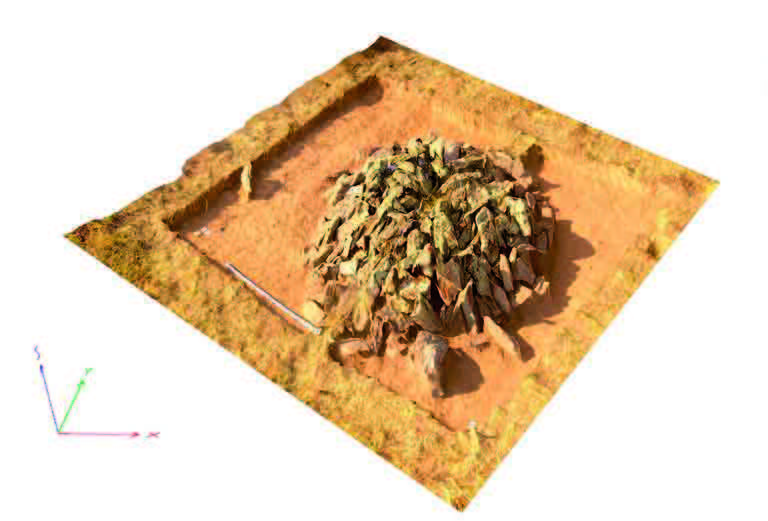RESEARCH OF ARCHAEOLOGICAL SITES ON TНE HILL SARYADYR (archeology & altitude shooting)
DOI:
https://doi.org/10.52967/akz2021.1.11.54.71Keywords:
archaeology, Kypchak burial tradition, stele, koytas, Begazy-Dandybay culture, toponymAbstract
The article presents the results of a study of two burial structures on the Saryadyr hill (Karagandy region, Ulytau district, Korgasyn village). The objects are located in the area of the Karatorgay mountain range paralleled to Karatorgay river. This area is
unknown in archaeological researching. Archaeological excavations in combination with high-altitude survey revealed the features of the location of sites in the local landscape. The cultural and chronological position of the structures was determined by the peculiarities of the funeral rite. The Saryadyr 1 is a stone structure with vertical steles belonging to the late
Kypchak burial tradition of the 13th – first half of the 14th centuries. The original burial rite is in the form of a composition of individual parts of the legs with inventory such as an iron knife and an arrowhead. Another structure, the Saryadyr 2 mound, apparently had a memorial character and belonged to the category of cenotaphs. A lying flat stele of the type of “koytas”
was in its design. The ritual structure belongs to the Begazy-Dandybay culture of the late Bronze age. A comparative analysis of the meaning of the toponym Saryadyr with the archaic rites of the excavated structures indicated the sacred significance of the hill in the context of the culture of the nomads of Ulytau.
References
Bisembayev, A. A. 2003. Arkheologicheskiye pamyatniki kochevnikov srednevekoviya Zapadnogo Kazakhstana (VIII–XVIII vv.) (Archaeological sites of the nomads of the Middle Ages of Western Kazakhstan (VIII–XVIII centuries). Uralsk: West Kazakhstan regional center of history and archeology Publ. (in Russian).
Botalov, S. G. 2019. U istokov yuzhnouralskikh narodov. Yuzhnyy Ural v epokhu Zolotoy Ordy (IX – nachalo XV veka) (At the origins of the South Ural peoples. Southern Urals in the era of the Golden Horde (IX – early XV centuries). 8 vol. Vol. 5. Chelyabinsk: South Ural State University Publ. (in Russian).
Geologicheskaya harakteristika mestorozhdeniya Kurgasyn (Geological characteristics of the Kurgasyn deposit). URL: https://studbooks.net/1772478/geografiya/geologicheskaya_harakteristika#16
Janaydarov, O. K. 2014. Kazakh jerinin 100 anyz (100 Legends of the Kazakh land). Vol. 4. Almaty: “Soraba” Publ. (in Kazakh).
Ivanov, V. I., Kriger, V. A. 1988. Kurgany kypchakskogo vremeni na Yuzhnom Urale. (Mounds of the Kypchak time in the South Urals). Moscow: “Nauka” Publ. (in Russian).
Ivanov, V. I. 2013. In: Tyurkskiye kochevniki Yevrazii (kimaki, kipchaki, polovtsy…) (Turkic nomads of Eurasia (Kimaks, Kipchaks, Polovtsians...)). Vol. 2. Kazan: “Ikhlas” Publ.; Sh. Marjani Institute of History AN RT, 77–100 (in Russian).
Kazakh tilinin sozdigi (Dictionary of the Kazakh language). 1999. Almaty: “Dayk Press” Publ. (in Kazakh).
Kononov, A. N. 1975 (1978). Tyurkologicheskiy sbornik (Turkological collection). Moscow: “Eastern Literature” Publ., 159–179 (in Russian).
Karaturgaj, gornyj kryazh (Karaturgai, mountain range). URL: https://ru.wikisource.org/wiki/ЭСБЕ/Каратургай,_горный_кряж
Margulan, A. Kh. 1979. Begazy-dandybayevskaya kultura Tsentralnogo Kazakhstana. (Begazy-Dandybay culture of Central Kazakhstan). Alma-Ata: “Nauka” KazSSR (in Russian).
Mogilnikov, V. A. 1981. In: Archeology of USSR. Moscow: “Nauka” Publ., 194‑200 (in Russian).
Nurmaganbetov, A. 1994. Bes zhүz bes soz (Five hundred five words). Almaty: “Rauan” Publ. (in Kazakh).
Usmanova, E. R., Dremov, I. I., Panyushkina, I. P., Kolbina, A. V. 2018. In: Archeology, Ethnography and Anthropology of Eurasia, 46, No. 2, 106–113 (in Russian).
Yskakov, A., Syzdykova, R., Sarybayev, Sh. 1966. Kazakh tilinin kyskasha etymology sozdigi (Short Etymological Dictionary of the Kazakh language). Almaty: “Nauka” Publ. (in Kazakh).
Yarygin, S. A. 2011. In: Baitanayev, B. A., Beisenov, A. Z. (eds.). Arheologiya Kazahstana v epohu Nezavisimosti: itogi, perspektivy (Archeology of Kazakhstan in the era of Independence: results, prospects). Vol. 1. Almaty: A.Kh. Margulan Institute of Archeology, 408–416 (in Russian).

Downloads
Published
How to Cite
Issue
Section
License
Copyright (c) 2021 Emma R. Usmanova, Jambul A. Jumabekov, Erbolat Zh. Rakhmankulov, Aydin S. Zhuniskhanov, Syrym Yessen

This work is licensed under a Creative Commons Attribution-NonCommercial 4.0 International License.






